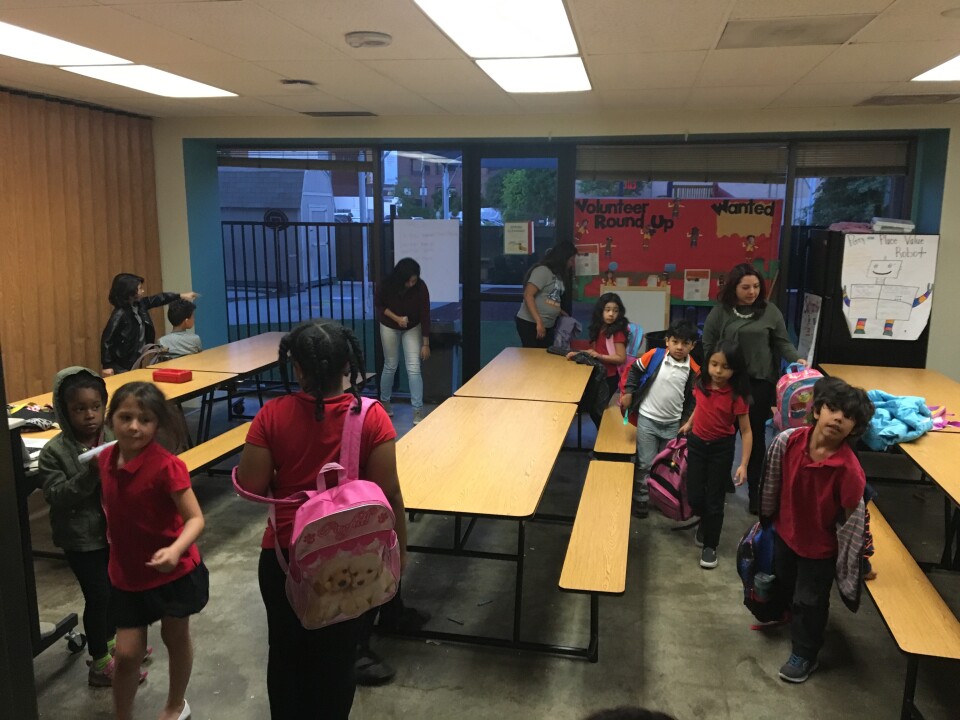Truth matters. Community matters. Your support makes both possible. LAist is one of the few places where news remains independent and free from political and corporate influence. Stand up for truth and for LAist. Make your year-end tax-deductible gift now.
This archival content was originally written for and published on KPCC.org. Keep in mind that links and images may no longer work — and references may be outdated.
Charter Schools Sharing LAUSD Campuses: Nobody Loves It, Everyone Has To Live With It

Martin Wong and Wendy Lau were frustrated. They'd gotten a letter from the Los Angeles Unified School District saying their daughter's school, Castelar Street Elementary in Chinatown, might have to turn over several classrooms to a charter school.
Most frustrating about the letter, dated February 27, was that Wong and Lau could do little to stop Metro Charter School from "co-locating" on the district's property — a California law known as Prop 39 says school districts must open up their campuses to charter schools searching for a building.
"We're thinking, 'What?'" Wong said. "'How can all this happen without involving parents?'"
But unbeknownst to Wong, Lau and many parents at Castelar, leaders of Metro Charter School had their own frustration's with the district's proposed arrangement.
The district said Metro Charter School's request was essentially for 12 classrooms. But L.A. Unified assigned only five classrooms at Castelar to the co-location. The rest of the rooms the district offered were at two other district schools.
"The proposal was for us to split ourselves into three campuses," said Apurva Pande, a member of Metro Charter School's board. Accepting the offer, board members decided, would be neither logistically nor financially viable.
So Metro turned down the district's co-location offer, despite a desperate need for more space.
The political friction between L.A. Unified and charter schools makes it easy to forget the two sides are often so much more than neighbors — they're practically roommates. More than 19,000 students attend a charter school that operates on a school district site. One out of every three independent charter schools in Los Angeles is co-located, many under Prop 39 — and some of the arrangements are peaceful and mutually beneficial.
But the frustrations that ended the Metro-Castelar co-location before it could begin are also common. Some charter school advocates suspect the district is mismanaging the process of assigning co-locations — and have argued as much in court. But district sympathizers say parents at Castelar, or at any school selected for co-location, had a right to be worried.
"There are co-location sites that work better than others when there really is an effort to share space," said L.A. School Board president Steve Zimmer. "But make no mistake: this is a broken system, a broken law, it needs to be changed.
"This is a zero-sum game," he added, "that is set up to create winners and losers. And most often — not always, but most often — it’s the host district school that loses. They lose space. They lose students."
With their passage of Prop 39 in 2000, California voters expanded charter schools rights to district space. No longer would state law only require districts to share unused, surplus space with charter schools; district would have to ensure its facilities could be "fairly shared" by all public school students, including charter students.
Under Prop 39, districts must offer charter schools "reasonably equivalent … facilities that will sufficiently accommodate all of the charter’s in-district students." School districts can't charge rent, but can collect fees from co-located charter schools for expenses like maintenance and security services. The schools' principals negotiate plans to share spaces like libraries, cafeterias, gymnasiums and playgrounds.
Since Los Angeles real estate is expensive, finding suitable space to lease is difficult, city permitting can be a hassle and charters' access to bond money to build their own buildings limited, co-location is often an "expedient" option for many new charter schools, said Myrna Castrejon, executive director of the pro-charter school group Great Public Schools Now.
Castrejon said on some of the most harmonious co-location sites, charter and district-run schools are sharing extracurricular programs and professional development for teachers.

But discord from troubled co-location sites can drown out the harmony. At Castelar Street Elementary, for instance, parents protested that the rooms they stood to lose were actually in use. Two house a music program. The principal planned to turn another, currently a science room, into another computer lab for state testing.
Wong and Lau pointed out the loss of six rooms — five for classrooms, one for an office — would make it more difficult for Castelar to grow its Mandarin dual language program, which had become a selling point for the school.
But charter school advocates — while acknowledging the difficulty of L.A. Unified officials' task to find space to offer to all 95 charters that applied for Prop 39 space — aren't convinced their schools receive all of the space to which they're entitled. Last year, the state Supreme Court ruled L.A. Unified officials were "undercounting" the number of classrooms available to share with charters.
In addition, the type of "split-site" co-location offer that Metro Charter found to be logistically and financially unworkable has become more common.
Two years ago, L.A. Unified's made eight co-location offers that involved multiple sites; last year, the district made split-site offers to seven charters, according to a count from the California Charter Schools Association (CCSA).
This year, the district offered 19 split-site co-locations. They've made 24 such offers for next year, according to the association.

José Cole-Gutiérrez, who heads L.A. Unified's Charter Schools Division and oversees the Prop 39 application process, said it's not fair to read into the higher numbers of split-site offers without considering the locations of these offers. He said in certain areas of Los Angeles, district officials are simply unable to find space where charters can co-locate on a single site.
"L.A. Unified understands and respects its obligation and takes it very seriously that we provide the space under Prop 39," said Cole-Gutiérrez. "Especially in those impacted areas [where available co-location space is already scarce], it will continue to be a challenge where we have to balance the needs of all the students in those areas."
His office's task may be even more difficult if an expansion of charter schools moves forward. A leaked draft of a plan from Great Public Schools Now, which counts the Broad Foundation among its funders, calls for adding more than 130,000 new charter school seats in L.A. The plan's calculations count on Prop 39 space to account for some of those new seats.
"Prop 39 is the epitome of everything that has changed in the charter movement from its inception — to be an incubator for change, and transformation, and innovation — to now being simply an instrument for competition," said board president Zimmer. But he also added the district's past implementation of Prop 39 has contributed to some of the discord.
"In the previous administration, co-location was viewed as a punishment" for underwhelming enrollment figures, he said.
The district could correct for that, Zimmer suggested, by offering host schools in co-locations financial bonuses or priority in maintenance requests. But he also called on state-level officials to correct co-location policies by offering clearer ground rules and a more level playing field.
Castrejon, of Great Public Schools Now, also suggested the state could alleviate some of the pressure on Prop 39 by making it easier for charter schools to access public funds for construction.
Others have suggested, in general, school districts could do more to include charter schools on their facilities bonds.
There are co-location success stories, Castrejon said: "I don't think that it's necessarily by default an option that doesn't work."
But do the troublesome co-locations outnumber the success stories?
"There’s a lot of work left to do," Castrejon replied. "No question."
About this story
This story was originally published on KPCC.org prior to Southern California Public Radio acquiring LAist in 2018.
Updated September 25, 2023 at 1:30 PM PDT
This story was republished on LAist.com on this date.







